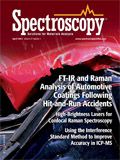Spectroscopy Spotlight
Spectroscopy Spotlight
As interest increases in expanding the use of renewable energy, companies like DuPont are developing new photovoltaic materials for use in solar panels. Spectroscopy recently spoke to Dr. Wayne Brubaker, senior research chemist at Dupont's Corporate Center for Analytical Sciences, about the use of X-ray fluorescence spectroscopy in the analysis of those materials, during both development and manufacturing.
What types of photovoltaic materials do you analyze with X-ray fluorescence? And do you use other X-ray techniques as well?
Brubaker: For years, my colleagues and I within DuPont's Corporate Center for Analytical Sciences have provided analytical problem solving to support the development and manufacture of materials that are widely used in today's photovoltaic modules. Examples of such products include fluoropolymer and polyvinyl fluoride materials for frontsheet and backsheet applications, respectively, as well as pastes used for metallization within modules.
The intensification of research and development (R&D) efforts across the photovoltaics industry has presented new opportunities to showcase the capabilities of X-ray analysis. For example, in the development of new active-layer materials, X-ray fluorescence (XRF) spectroscopy is used to determine elemental stoichiometry, while X-ray absorption near edge structure (XANES) fingerprinting provides for quantitative phase speciation in this system. X-ray reflectivity (XRR), like XRF, can measure the thickness of thin films but can also go one step further than XRF by providing direct measurements of a film's density. The complementary information from these various X-ray techniques allows our researchers valuable insights into their new materials.
Are there challenges in using XRF for this work?
Brubaker: XRF is often selected for photovoltaic-related measurements because of its well-known attributes: It can be fast, highly quantitative, and often performed with little to no sample preparation. Also, compared to other elemental analysis techniques, such as inductively coupled plasma (ICP) spectroscopy or neutron activation analysis (NAA), XRF has a much greater potential to be used in at-line or online testing after materials advance beyond the R&D phase and into the realm of manufacturing and commercialization. It is much easier to transfer a method from the laboratory to the frontlines when the basic underlying technology remains the same.
I regularly tell colleagues that the most frequent challenge with developing quantitative XRF methods (perhaps 9 times out of 10) is acquiring acceptable standards for calibration, and this is particularly true with photovoltaic-related materials. The most accurate methods require well-characterized, matrix-matched standards because of XRF's susceptibility to inter-element and matrix effects. Samples related to our photovoltaic research tend to be unique and "first of a kind," meaning that standards are seldom available. We often have to characterize some samples by other techniques, such as ICP and NAA, so that those samples may ultimately serve as our standards. Other times, we have to be a bit more creative in coming up with standards. In one case, for example, we developed a fusion preparation that enabled us to make our own standards.
Could you explain how you use XRF for the characterization and quality control of metallization pastes?
Brubaker: Our metallization pastes represent a wide range of compositions, each highly specialized for an intended application. Pastes for frontside metallizations, for example, consist primarily of silver, whereas aluminum tends to be the major component of backside pastes. Various glass frit materials are also introduced into compositions to provide adhesion properties when an end user fires a paste onto a substrate.
These pastes are largely inorganic in nature; therefore, XRF provides an excellent means for their elemental characterization. By XRF we can measure a paste nondestructively —"as received" on just a thin polypropylene film support — allowing the sample to be retained for additional testing and thus conserving as much of the high valued material as possible. (Remember that silver is not cheap these days.) High-concentration elements such as Ag and Al are best determined by XRF's fundamental parameters methodology; at the same time, a minimal amount of sample also has to be analyzed by ICP to determine any trace elements and contaminants, given the lack of XRF standards for such a variety of paste compositions. We have found this complementary approach of using both XRF and ICP gives our teams the most complete and efficient "elemental picture" of the pastes.
This interview was edited for length and clarity.
For the full interview with Brubaker, please visit:www.spectroscopyonline.com/Brubaker

LIBS Illuminates the Hidden Health Risks of Indoor Welding and Soldering
April 23rd 2025A new dual-spectroscopy approach reveals real-time pollution threats in indoor workspaces. Chinese researchers have pioneered the use of laser-induced breakdown spectroscopy (LIBS) and aerosol mass spectrometry to uncover and monitor harmful heavy metal and dust emissions from soldering and welding in real-time. These complementary tools offer a fast, accurate means to evaluate air quality threats in industrial and indoor environments—where people spend most of their time.
NIR Spectroscopy Explored as Sustainable Approach to Detecting Bovine Mastitis
April 23rd 2025A new study published in Applied Food Research demonstrates that near-infrared spectroscopy (NIRS) can effectively detect subclinical bovine mastitis in milk, offering a fast, non-invasive method to guide targeted antibiotic treatment and support sustainable dairy practices.
Smarter Sensors, Cleaner Earth Using AI and IoT for Pollution Monitoring
April 22nd 2025A global research team has detailed how smart sensors, artificial intelligence (AI), machine learning, and Internet of Things (IoT) technologies are transforming the detection and management of environmental pollutants. Their comprehensive review highlights how spectroscopy and sensor networks are now key tools in real-time pollution tracking.